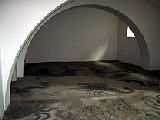 |
Through Via Crescimbeni you get to the Roman “trivium” (the crossing of the two main streets), the crossing with the former Via Flaminia, now Corso Matteotti. Turning right, on its right rises the Palazzo Lepri, built at the emnd of the 17th century by Andrea Vici on plans of Valadier, which house the Town Hall and the Museo Civico with an archaeological section in the staircase of the palazzo( with remains from the archaic to the imperial era) and the pinacoteca (gallery), with works of Dono Doni (“Our Lady with Child”), of “Fantino” (= Ascensidonio Spacca)(wooden coffin of the Blessed Giacomo), of Andrea Camassei, of Corrado Ciaquinto (“Holy Family”).
At the entrance of the Corso Matteotti into the main square of the town on the left rises the Chiesa di S. Domenico e del Beato Giacomo, built in 1291 on top of an oratory, dedicated to St. George, a present of the commune to the Blessed Giacomo Bianconi in recognition of its role in the reconstruction of the town after the siege by Frederick II (1249). The front shows a beautiful portal of the 14th century with a frescoed lunette. The single-naved interior with three apses has been transformed in 1737. In the central apse there are still some Giotto-style frescoes of the 14th century , “Annunciation” and “Scenes of the life of St. Dominic”; in the side apses, wooden sculptures of the 13th century: “Our Lady with Child” and “Crucified”. The church and the contiguous houses hide the huge former Dominican convent, which had been built on top of a public Roman building of the 1st century (an alley behind the church leads to the foundations).








